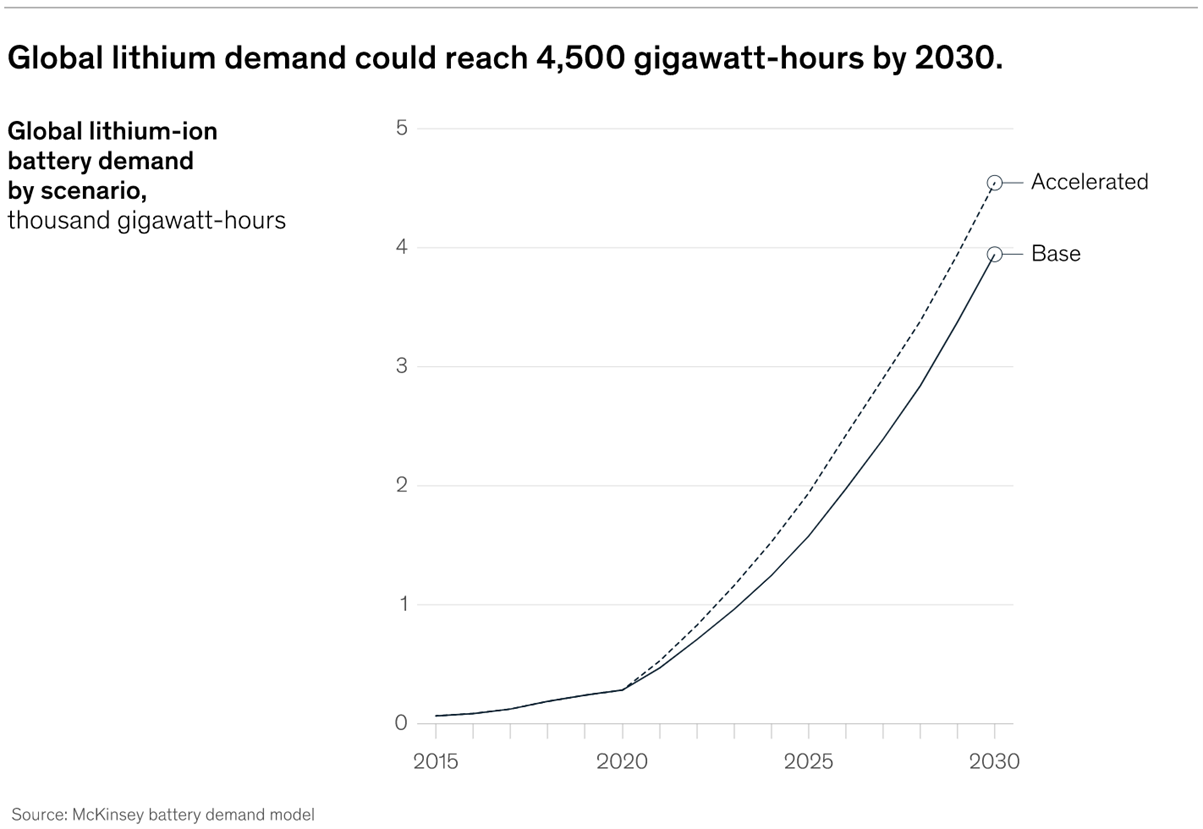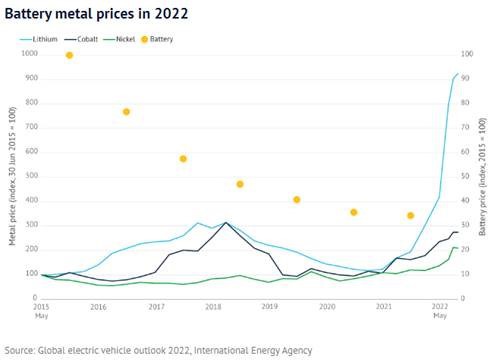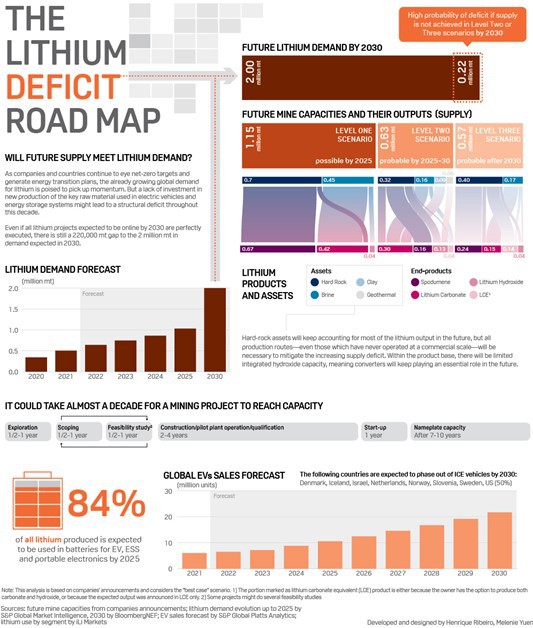The price of lithium has increased almost 500% in the past year . The material, which is crucial for the development of lithium-ion batteries, is used to power a variety of digital items from computers to Teslas to harnessing energy on solar panels. Lithium has been utilised in hundreds of different products like glass, ceramics, pharmaceuticals, aluminum and magnesium alloys being the most common. The current price explosion is due to the booming electric vehicle market and the worldwide transition towards renewable and sustainable transportation and energy solutions.
.png.aspx)
Source: Ablemarle
This extreme surge in price has some spooked with banking giants like Goldman Sachs and Credit Suisse suggesting the impressive rally will go into reverse this year as supply from unconventional new suppliers overwhelms demand.
Where then might these new supplies come from and what is the outlook for this vital resource?
Future Investments
China views lithium as the new “Gold Rush” and is on a mission to hunt down and secure new deposits. The idea behind this strategy is that it allows Chinese automakers and battery manufacturers to directly mine and refine at scale, ensuring a consistent supply for the world's largest electric vehicle (EV) market.
With half of the world’s lithium resources situated in South America and Australia, China is turning to Africa in search of securing deposits. BYD, a Shenzen based conglomerate with major automobile and electronics divisions, is in discussions for the acquisition of six new lithium mines in unspecified African countries. Another Chinese resources company, Zhejiang Huayou Cobalt, is also buying up African mines with a recent investment of $300M in a Zimbabwean lithium site.
The recent explosion in lithium prices may recede in the short term but the long term strategy is what most countries are focused on. The US, who have been slow to act and invest in Africa, sees the importance of the continent’s resources with General Stephen Townsend, AFRICOM commander saying,
"Africa possesses vast untapped energy deposits needed for the transition to clean energy as well as mobile phones, jet engines, electric hybrid vehicles and missile guidance systems."
He further added, "The winners and losers of the 21st century global economy may be determined by whether these resources are available in an open and transparent marketplace or are inaccessible due to predatory practices of competitors.”
McKinsey and Company, a consulting firm, supports the notion that supply will be crucial with demand set to grow from 500,000 metric tons in 2021 to some 3 to 4 million tons in 2030. The demand for this six-to-eight-fold increase - see exhibit 1 - primarily revolves around the uptake of EVs as well as energy storage systems such as e-bikes, tools and other battery intensive items. For example, EV sales doubled in 2021 creating a market value equivalent to approximately USD$185 billion. By 2028, the EV market is projected to reach a staggering value of close to a trillion dollars – a compound annual growth rate (CAGR) of 24.5%.

Controlling Price
The market price of the mineral's raw ore has soared to about US$6,000 (AUD$8,300) a tonne thanks to the accelerating shift to renewable energy at a time when supply is still trying to catch up.
Saul Kavonic, head of energy resources research at Credit Suisse, says “prices have gone through the roof with scarcity of lithium now a fundamentally bad thing.”
The issue lies in the 30% increase in battery costs which are driving prices for products like EVs and solar batteries, both being important products contributing towards reducing global emissions. These eye-watering price increases would be enough for many to veer away from investing in an EV or installing a solar power battery system in a residential or commercial building.

The price of lithium needs to be controlled, therefore further mass adoption of these decarbonising products is to take place. Kavonic believes this control will likely be in the way of lithium supply catching up with demand and quite possibly creating a surplus, assuming proposed lithium mines that are under construction in Australia and globally, open on time.
Some analysts, like lithium and mining expert Joe Lowry aka “Mr Lithium”, believe the gap between supply and demand will continue to grow, even as car companies like Tesla raise their prices and new lithium suppliers hit the market. Extracting lithium is a complicated process that involves mining the ore and then separating the metal or by pumping underground water deposits to the surface and then extracting the metal from pools, a common practice in South America.
“You can build a battery factory in two years, but it takes up to a decade to bring on a lithium project,” Lowry said.
S&P, the world's foremost provider of ratings, benchmarks, and analytics in the global capital and commodity markets, tends to agree that a shortage in supply is likely if certain scenarios are not met within the industry – see infographic below.

A contender on the horizon?
Should lithium fail to meet market demands and in essence, slow down the progression towards decarbonising economies, an alternative energy source could plug the gap.
Hydrogen fuel cells can be used in a wide range of applications, including transportation, material handling and stationary, portable, and emergency backup power. The technology for vehicles is still rather new with only two cars – the Toyota Mirai and the Hyundai Nexo – currently available in select countries.
The technology from a transportation standpoint offers several benefits such as:
- Faster refuelling than EVs
- Greater range of travel between refuelling
- Up to 400kg lighter than an EV
- Can be transitioned to multiple vehicle types with ease
- Lower longer term infrastructure cost
The hydrogen fuel cell market reached a value of US$6.6 billion in 2021 which is projected to eclipse US$19 billion by 2027, a CAGR of 21%. This exciting technology, once scalable and efficient, could be useful should lithium supply continue to lag demand over the next decade.
The surge in both the price and demand of lithium is certainly a point of concern. The switch to EVs and energy harnessing batteries is part of the solution to decarbonisation and meeting climate change goals. Lithium therefore is fast becoming the most crucial resource to help humanity reach energy targets but as we are seeing, supply is struggling to keep up with demand that is not only affecting output but also pricing many consumers out of the market. Should supply not meet demand over the coming decade, contenders like that of hydrogen fuel cell technology are likely to fill the void and potentially challenge lithium for years to come.
20 Jun